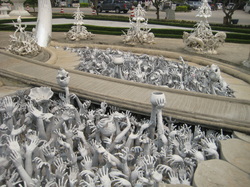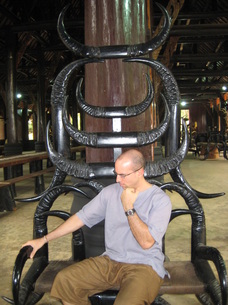

After leaving Chiang Mai, we headed further North to the city of Chiang Rai. Situated close to the “Golden Triangle” (where the border of Laos, Myanmar, and Thailand meet), this region became infamous for its sprawling opium fields in the 1960’s-1980’s. Now most of the opium has been replaced by other legal cash crops (tea, coffee, corn, etc…), but tourists still come to tour the area, which is rich in natural beauty.  The Suffering Masses Having only a short time, we opted to explore the artistic and sacred side of Chiang Rai – represented by two opposing colors: Black and White. Our first stop was the White Temple (Wat Rong Khun), a recent architectural achievement by artist Chalermchai Kositpipat. Kositpipat veered away from the traditional gold coloring of Thai temples because he thought white better represented the purity of the enlightened state than the mercantile color of gold. The outside of the temple is a magnificent sight to behold – glittering white in the light, its sharp lines bringing an immediate feeling of awe. It almost oddly resembles a winter wonderland that somehow found itself in steamy Thailand. The entryway to the temple portrays humans and demons reaching up out of a pit of suffering – a symbol the artist says represents the suffering all beings must go through before reaching enlightenment. After passing over a bridge guarded by two giant demons, visitors enter the temple where a large white marble Buddha sits. On the wall in front of the Buddha are scenes of demons feeding on human suffering – missiles, whisky, pollution, etc… while on the walls on the side and behind the Buddha faithful practitioners are portrayed moving towards the heavenly realms. Perhaps most oddly, on the “demon wall”, there is a variety of science fiction and pop-culture icons moving around the demons. We saw Keanu Reeves from the matrix, the Hulk, Spiderman, the Predator, Darth Vader, even an Angry Bird from the iPhone game! Needless to say, the artist seemed to get a little carried away at this point as we struggled to understand what we were seeing and how it related to the overall message.  Jeff doing his best Conan impersonation The White Temple was about 13 kilometers south of town and after visiting, we headed about 25 kilometers north to the grounds of the Black Temple (Baan Si Dum). We found it to be opposite not just in color, but in style as well. Baan Si Dum is a complex of many buildings sharing the theme of artist Thawan Duchanee. It is dominated by a large Black Temple, filled with animal skins laid on long wooden tables and black chairs with buffalo horns at the top. There are also intricate wooden carvings depicting demons struggling with each other on the doorways. The rest of the grounds is littered with buildings that the artists didn’t have open that day. But walking among we saw common themes – animal bones (shark jaws, monkey skulls, etc…) and furs laid out domestically with bone carved furniture and Buddhist iconography. It was almost like a vision of a barbaric jungle king’s palace after he had converted to Buddhism. After the “bling” of the white temple, the Black Temple’s eerie scenes seemed to call the visitor towards the contemplation of death and the ephemeral aspect of our existence. Some writers have described these temples as representing the heaven and hell of Buddhism. Neda and I couldn’t help but chuckle as we read that description. How ironic that these two temples have come to represent as stark a dualism as heaven and hell. In actuality, Buddhism is all about moving beyond the idea of dualism to find the interconnected whole. Heaven and hell, in this regard, are two sides of the same coin. We can be in paradise with our self-focused thoughts and find pain and alienation or we can be in hell with a right understanding of our interconnectedness and find peace and repose. Perhaps thinking of the black and white temples as two separate pieces is the problem in the first place. If we go beyond their differences and find the common message of impermanence and surrender that they implore, we find a deeper meaning than either piece has on its own. We left Chiang Rai this morning, drove 3 hours and crossed the border into Laos. Our next stop is the Bokeo Nature Reserve where we will zipline hundreds of meters above the jungle floor in search of the elusive Black Gibbon! In the meantime, see the rest of Chiang Rai and the two temples here: http://flic.kr/s/aHsjyNTZGh
0 Comments
Leave a Reply. |